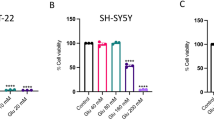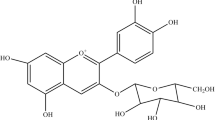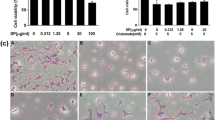Abstract
The present study has been designed to explore the molecular mechanism and signaling pathway targets of chlorogenic acid (CGA) and its main hydrolysates, caffeic (CA) and quinic acid in the protective effect against glutamate-excitotoxicity. For this purpose 8-DIV cortical neurons in primary culture were exposed to 50 μM l-glutamic acid plus 10 µM glycine, with or without 10–100 μM tested compounds. Chlorogenic acid and caffeic acid via their antioxidant properties inhibited cell death induced by glutamate in dose depended manner. However, quinic acid slightly protects neurons at a higher dose. DCF, JC-1 and Ca2+sensitive fluorescent dye fura-2, were used to measure intracellular ROS accumulation, mitochondrial membrane potential integration and intracellular calcium concentration [Ca2+] i . Results indicate that similarly, CGA acts as a protective agent against glutamate-induced cortical neurons injury by suppressing the accumulation of endogenous ROS and restore the mitochondrial membrane potential, activate the enzymatic antioxidant system by the increase levels of SOD activity and modulate the rise of intracellular calcium levels by increasing the rise of intracellular concentrations of Ca2+caused by glutamate overstimulation. PKC signaling cascade appear to be engaged in this protective mechanism. Interseling, CGA and CA also exhibit antiapoptotic properties against glutamate-induced cleaved activation of pro-caspases; caspase 1,8 and 9 and calpain (PD 150606,Calpeptin and MDL 28170).These data suggest that neuroprotective activity of CGA ester may occurs throught its hydrolysate,the caffeic acid and its interaction with intracellular molecules suggesting that CGA exert its neuroprotection via its caffeoly acid group that might potentially be used as a therapeutic agent in neurodegeneratives disorders associated with glutamate excitotoxicity.








Similar content being viewed by others
Abbreviations
- CNS:
-
Central nervous system
- DCF:
-
Dichlorofluorescein
- FDA:
-
Fluorescein diacetate
- H2O2 :
-
Hydrogen peroxide
- LDH:
-
Lactate dehydrogenase
- PKA:
-
Protein kinase A
- PKC:
-
Protein kinase C
- PLC:
-
Phospholipase C
- ROS:
-
Reactive oxygen species
- MAPK:
-
Mitogen apoptotic protein kinase
- DPPH:
-
2, 2-diphenyl-1-picrylhydrazyl
- DCF:
-
2’, 7’-dichlorofluorescein
- CGA:
-
Chlorogenic acid
- CA:
-
Caffeic
- QA:
-
Quinic acid
- PBS:
-
Phosphate-buffered saline
- LDH:
-
Lactate deshydrogenase
- CAT:
-
Catalase
- SOD:
-
Superoxide dismutase
- NMDA:
-
N-methyl-d-aspartate
- DMSO:
-
Dimethyl sulfoxide
- HBSS:
-
Hank’s Balanced Salt Solution
References
Martindale JL, Holbrook NJ (2002) Cellular response to oxidative stress: signaling for suicide and survival. J Cell Physiol 192:1–15
Blandini F, Greenamyre JT, Nappi G (1996) The role of glutamate in the pathophysiology of Parkinson’s disease. Funct Neurol 11:3–15
Zeron MM, Chen N, Moshaver A, Lee AT, Wellington CL, Raymond MR (2001) Mutant huntingtin enhances excitotoxic cell death. Mol Cell Neurosci 17:41–53
Choi DW (1988) Glutamate neurotoxicity and diseases of the nervous system. Neuron 1:623–634
Dos Santos MD, Almeida MC, Lopes NP, De Souza G (2006) Evaluation of the antiinflammatory, analgesic and antipyretic activities of the natural polyphenol chlorogenic acid. Biol Pharm Bull 29:2236–2240
Kwon SH, Lee HK, Kim JA, Hong SI, Kim HC, Park YI, Lee CK, Lee YB, Lee SY, Jang CG (2010) Neuroprotective effects of chlorogenic acid on scopolamine-induced amnesia via anti-acetylcholinesterase and anti-oxidative activities in mice. Eur J Pharmacol 649:210–217
Kim J, Lee S, Shim J, Kim HW, Kim J, Young JJ, Yang H, Park J, Choi SH, Yoon JH, Lee KW, Lee HJ (2012) Caffeinated coffee, decaffeinated coffee, and the phenolic phytochemical chlorogenic acid up-regulate NQO1 expression and prevent H2O2-induced apoptosis in primary cortical neurons. Neurochem Int 60:466–474
Mattila P, Pihlava JM, Hellstrom J (2005) Contents of phenolic acids, alkyl- and alkenylresorcinols, and avenanthramides in commercial grain products. J Agric Food Chem 53:8290–8295
Pavlica S, Gebhardt R (2005) Protective effects of ellagic and chlorogenic acids against oxidative stress in PC12 cells. Free Radic Res 39:1377–1390
Vauzour D, Corona G, Spencer JPE (2010) Caffeic acid, tyrosol and p-coumaric acid are potent inhibitors of 5-S-cysteinyl-dopamine induced neurotoxicity. Arch Biochem Biophys 501(1):106–111
Vauzour D, Vafeiadou K, Spencer J JPE (2007) Inhibition of the formation of the neurotoxin 5-S-cysteinyl-dopamine by polyphenols. Biochem Biophys Res Commun 362(2):340–346
Yang JQ, Zhou QX, Liu BZ, He BC (2008) Protection of mouse brain from aluminum-induced damage by caffeic acid. CNS Neurosci Ther 14(1):10–16
Zhou Y, Fang SH, Ye YL, Chu LS, Zhang WP, Wang ML, Wei EQ (2006) Caffeic acid ameliorates early and delayed brain injuries after focal cerebral ischemia in rats. Acta Pharmacol Sin 27:1103–1110
Kalonia H et al (2009) Effect of caffeic acid and rofecoxib and their combination against intrastriatal quinolinic acid induced oxidative damage, mitochondrial and histological alterations in rats. Inflammopharmacology 17:211–219
Hur JY, Soh Y, Kim BH, Suk K, Sohn NW, Kim HC, Kwon HC, Lee KR, Kim SY (2001) Neuroprotective and neurotrophic effects of quinic acids from Aster scaber in PC12 cells. Biol Pharm Bull 24:921–924
Taram F, Winter AN, Linseman DA (2016) Neuroprotection comparison of chlorogenic acid and its metabolites against mechanistically distinct cell death-inducing agent sin cultured cerebellar granule neurons. Brain Res 1648:69–80
Mikami Y, Yamazawa T (2015)Chlorogenic acid, a polyphenol in coffee, protects neurons against glutamate neurotoxicity. Life Sci 139:69–74
Azuma K, Ippoushi K, Nakayama M et al (2000) Absorption of chlorogenic acid and caffeic acid in rats after oral administration. J Agric Food Chem 48:5496–5500
Zhang YM, Bhavnani B (2005) Glutamate-induced apoptosis in primary cortical neurons is inhibited by equine estrogens via down-regulation of caspase-3 and prevention of mitochondrial cytochrome c release. BMC Neurosci 6:13. https://bmcneurosci.biomedcentral.com/articles/10.1186/1471-2202-6-13
Olney JW (1969) Glutamate-induced retinal degeneration in neonatal mice. Electron microscopy of the acutely evolving lesion. J Neuropathol Exp Neurol 28:455–474
Anggreani E, Lee CY (2017) Neuroprotective effect of chlorogenic acids against Alzheimer’s disease. Int J Food Sci Nutr Diet 6(1):330–337
Dupas C, Baglieri AM, Ordonaud C, Tom D, Maillard M (2006) Chlorogenic acid is poorly absorbed, independently of the food matrix: a Caco-2 cells and rat chronic absorption study. Mol Nutr Food Res 50:1053–1060
Campos-Esparza R, Sanchez-Gomez MV, Matute C (2009) Molecular mechanisms of neuroprotection by two natural antioxidant polyphenols. Cell Calcium 45:358–368
Ibarretxe G, Sánchez-Gómez MV, Campos-Esparza MR, Alberdi E, Matute C (2006) Differential oxidative stress in oligodendrocytes and neurons after excitotoxic insults and protection by natural polyphénols. Glia 53(2):201–211
RiceEvanc C (2001) Flavonoid-antioxidant. Curr Med Chem 8:797–807
Gottlieb M et al (2006) Neuroprotection by two polyphenols following excitotoxicity and experimental ischemia. Neurobiol Dis 23:374–386
Kono Y, Kobayashi K, Tagawa S, Adachi K, Ueda A, Sawa Y, Shibata H (1997) Antioxidant activity of polyphenolics in diets. Rate constants of reactions of chlorogenic acid and caffeic acid with reactive species of oxygen and nitrogen. Biochim Biophys Acta 1335(3):335–342
Rice-Evans CA, Miller JM, Paganga G (1996) Structure-antioxidant activity relationship of flavonoids and phenolic acids. Free Radic Biol Med 20:933–956
Sroka Z, Cisowski W (2003) Hydrogen peroxide scavenging, antioxidant and anti-radical activity of some phenolic acids. Food Chem Toxicol 41:753–758
Marinova EM, Toneva A, Yanishlieva N (2009) Comparison of the antioxidative properties of caffeic and chlorogenic acids. Food Chem 114:1498–1502
Nardini M, D’Aquino M, Tomassi G, Gentili V, Di Felice M, Scaccini C (1995) Inhibition of human low-density lipoprotein oxidation by caffeic acid and other hydroxycinnamic acid derivatives. Free Radic Biol Med 19:541–552
Hung TM, Na M, Thuong PT, Su ND, Sok D, Song KS, Seong YH, Bae K (2006) Antioxidant activity of caffeoyl quinic acid derivatives from the roots of Dipsacus asper Wall. J Ethnopharmacol 108:188–192
Genaro-Mattos TC, Maurício ÂQ, Rettori D, Alonso A, Hermes-Lima M (2015) Antioxidant activity of caffeic acid against iron-induced free radical generation—A chemical approach. PLoS ONE 10(11):14624
Andjelkovi M, Van Camp J, De Meulenaer B, Depaemelaere G, Socaciu C, Verloo M, Verhe R (2006) Iron-chelation properties of phenolic acids bearing catechol and galloyl groups. Food Chem 98:23–31
Heiss WD, Kessler J, Mielke R, Szelies B et al (1994) Long-term effects of phosphatidylserine, pyritinol, and cognitive training in Alzheimer’s disease: a neuropsychological EEG, PET investigation. Dementia 5:88–98
Noctor G, Foyer CH (1998) Ascorbate and glutathione: keeping active oxygen under control. Annu Rev Plant Biol 49:249–279
Matés JM (2000) Effects of antioxidant enzymes in the molecular control of reactive oxygen species toxicology. Toxicology 153:83–104
Hopper RK, Carroll S, Aponte AM, Johnson DT, French S, Shen RF, Witzmann FA, Harris RA, Balaban RS (2006) Mitochondrial matrix phosphoproteome: effect of extra mitochondrial calcium. Biochemistry 45:2524–2536
Kumar S, Suryanarayanan A, Boyd KN, Comerford CE, Lai MA, Ren Q, Morrow AL (2010) Ethanol reduces GABAA alpha1 subunit receptor surface expression by a protein kinase C gamma-dependent mechanism in cultured cerebral cortical neurons. Mol Pharmacol 77:793–803
Alkon DL, Sun MK, Nelson TJ (2007) PKC signaling deficits: a mechanistic hypothesis for the origins of Alzheimer’s disease. Trends Pharmacol Sci 28:51–60
Lin TY, Chung CY, Lu CW, Huang SK, Shieh JS, Wang SJ (2013) Local anesthetics inhibit glutamate release from rat cerebral cortex synaptosomes. Synapse 67:568–579
Orrenius S (2008) Reactive oxygen species in mitochondria-mediated cell death. Drug Metab Rev 39:443–455
White RJ, Reynolds IJ (1996) Mitochondrial depolarization in glutamate-stimulated neurons: an early signal specific to excitotoxin exposure. J Neurosci 16(18):5688–5697
Poręba M, Stróżyk A, Salvesen GS, Drąg M (2013) Caspase substrates and inhibitors. Cold Spring Harb Perspect Biol 5(8). doi:10.1101/cshperspect.a008680
Liu H, Radhakrishna B (2005) Endoplasmic reticulum stress–associated caspase 12 mediates cisplatin-induced LLC-PK1 cell apoptosis. JASN Express 16:1985–1992
Yuan B, Yankner A (2000) Apoptosis in the nervous system. Nature 407:802–809
Earnshaw WC, Martins LM, Kaufmann SH (1999) Mammalian caspases: structure, activation, substrates, and functions during apoptosis. Annu Rev Biochem 68:383–424
Leon R, Wu H, Jin Y, Wei J, Buddhala C, Prentice H, Wu JY (2009) Protective function of taurine in glutamate-induced apoptosis in cultured neurons. J Neurosci Res 87(5):1185–1194
Wang KW (2000) Calpain and caspases: can you tell the difference. Trends Neurosci 23:20–26
Wingrave JM, Schaecher KE, Sribnick EA, Wilford GG, Ray SK, Hazen-Martin DJ, Hogan EL, Banik L (2003) Early induction of secondary injury factors causing activation of calpain and mitochondria-mediated neuronal apoptosis following spinal cord injury in rats. J Neurosci Res 73(1):95–104
Acknowledgements
This work was supported by the Research Unit 00-UR-08-01 University of Sciences, Tunis and by a grant from the Tunisian, Ministry of Higher Education and Scientific Research Tunisia. The authors would like to thank Prof. Matute Carlos from the Instituto Del pays Vasco, Spain for their supportive advices. We acknowledge the financial support from the Ministry of Higher Education and Scientific Research (Tunisia).
Author information
Authors and Affiliations
Corresponding author
Rights and permissions
About this article
Cite this article
Rebai, O., Belkhir, M., Sanchez-Gomez, M.V. et al. Differential Molecular Targets for Neuroprotective Effect of Chlorogenic Acid and its Related Compounds Against Glutamate Induced Excitotoxicity and Oxidative Stress in Rat Cortical Neurons. Neurochem Res 42, 3559–3572 (2017). https://doi.org/10.1007/s11064-017-2403-9
Received:
Revised:
Accepted:
Published:
Issue Date:
DOI: https://doi.org/10.1007/s11064-017-2403-9




